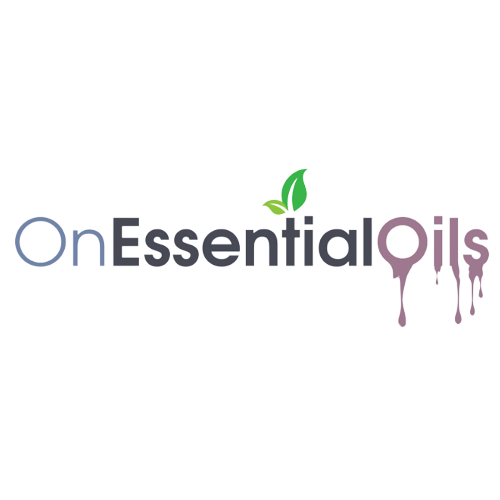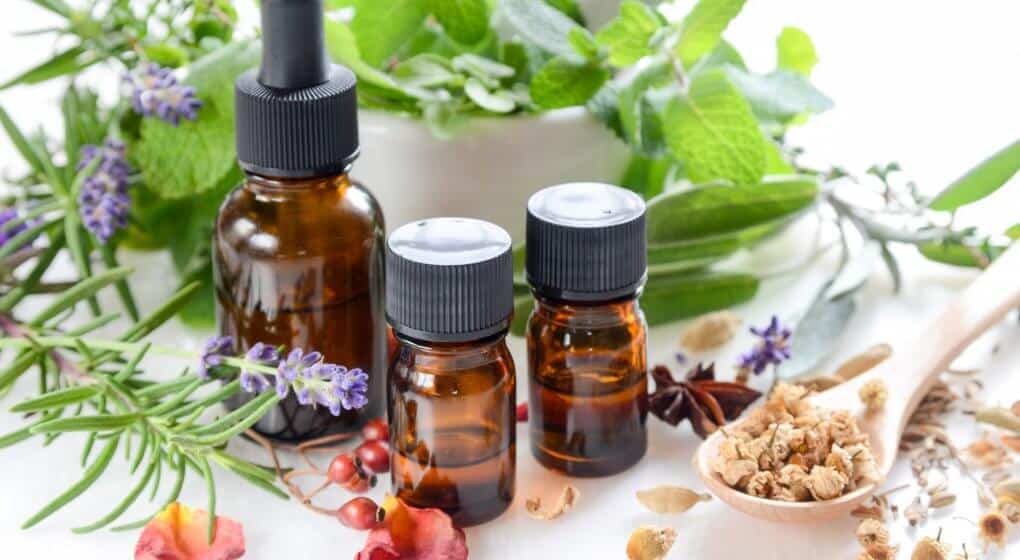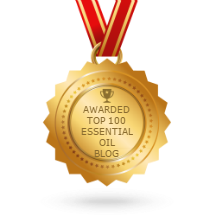
This is our massive guide to everything you need to know about essential oils. Use the table of contents above to navigate to the section that interests you, or just scroll through the article to learn more about each topic. There are useful lists of oils and tips throughout, so you’re sure to find something fascinating. If we missed anything, let us know in the comments and we’ll fix it!
Fresh plant material yields about 1-2% by weight of essential oil. [Tisserand, pg 6]. Essential oils can be extracted from many different plants and plant parts including resin, wood, bark, flowers, leaves, fruits, grasses, roots gums, etc. (pg. 8, Tisserand). With this, you can imagine the potency of essential oils.
There are approximately 350,000 plant species and out of those, around 5% (or 17,500) are used for their aromatic qualities. Of this 5%, more than 400 are processed for aromatic uses. Each essential oil can contain anywhere from 20-200 components (constituents).
Although essential oils contain many components that work together, one or two components often dominate their physiological activity. [1] For example, sweet basil (Ocimum basilicum ct linalool) contains typically 60% linalool while the other components of the oil are usually 5% or less. But there are many things that can affect or change the composition of the chemistry within an essential oil including seasonal variations such as climate change.
The chemical makeup is also dependent on location, soil type, age of the plant, and the time of year it is harvested. A former teacher told us that she always bought her Roman chamomile from the same distiller for years. Always reviewing the GC/MS analysis reports, she noticed a significant difference in the components of the oil. This would change how she would use the oil. When asked why the difference existed, the distiller stated they’d had a flood causing a mudslide which had changed the outcome of the composition of the essential oil.
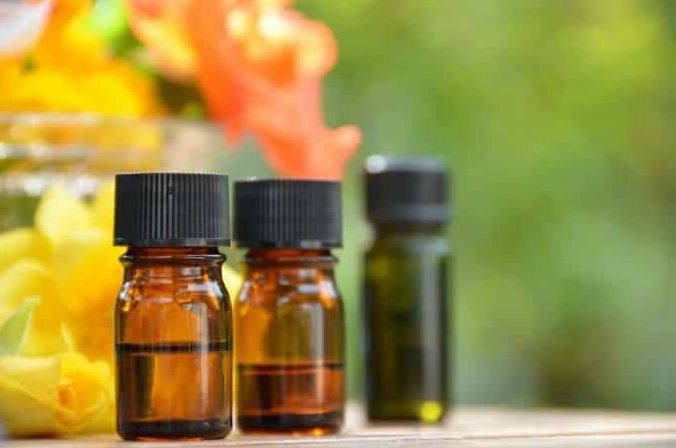
Lavender (Lavendula angustifolia) is one of the most popular of essential oils. Lavender is an anti-allergenic, immune stimulant, anti-bacterial, anti-inflammatory, anti-spasmodic, healing to our skin (in diluted form), and decongestant. This holds true for almost all essential oils. Although you may have heard they contain vitamins and minerals such as the parent plant, this is not possible. Why? Vitamins are either fat/lipid soluble or water soluble. Since essential oils do not contain water or fat/lipid, they would not be able to ‘hold’ vitamins within them.
However, the therapeutic benefits of essential oils are quite remarkable. Amongst many other properties previously mentioned and dependent on which essential oil, they are also mood enhancers, emotional stabilizers, antispasmodic, aperitive, neurotonic – and the list goes on.
The old adage “a little goes along way” applies to essential oils. These potent oils are effective in tiny doses. The typical, standard usage of essential oils that is considered safe is 2% (or 18 drops to 1 ounce) of a carrier oil or unscented lotion. 2% is very effective.
For acute or chronic issues, we may use up to 5-10% for a short period of time. However, that is dependent on the individual and the individual oil. Some essential oils, such as Thyme (Ct. thymol) are highly irritating and must be diluted at a maximum of 1% for healthy adult skin. We must dilute even more so for young, sensitive, or unhealthy skin. We will discuss safety at length later in this article.
Isolation of Essential Oils
Steam Distillation
There are several methods used to extract the volatile components of aromatic plants. However, to be a “true” essential oil, it must be either through steam distillation or cold expression. (5)
Historically, plant material was boiled to extract essential oils. This method was called hydro-distillation. Today, a few plants are hydro-distilled. This is the method used for roses. The rose petals are boiled rather than steam distilled.
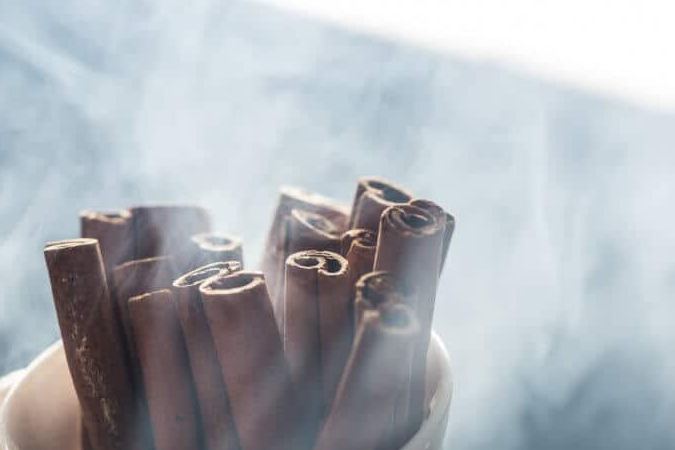
There are various other methods of distillation as well. For example, Enfleurage, Solvent Extraction, and CO2 Hypercritical Extraction methods are used for Absolutes and CO2 Extracts. Absolutes are extracted in a complex manner that requires the use of chemical solvents that are later removed during the final stages of production. A trace amount of the solvent, however, can remain in the final aromatic absolute. [6]
Like essential oils, absolutes are highly aromatic liquids extracted from plants. Although the amount of remaining solvent is considered tiny in carefully extracted absolutes, those that practice holistic aromatherapy prefer steam distilled essential oils.
Oils such as basil (herb), cinnamon (bark and leaves) Roman chamomile (flowers), eucalyptus (leaves), juniper berry (fruit), and lavender (flowers) are steam distilled. (7) (8)
Cold Pressed or Expressed Oils
Citrus oils are either steam distilled or extracted through cold pressed (expression) of the peeling of the fruit. Through cold expression, the larger molecules of concern that cause phototoxicity pass through. This is not always the case though.
Sweet orange does not have phototoxicity concerns. Some citrus plants produce more than oil from the fruit. For example, petitgrain (bigarade – Citrus aurantium var. amara or Bigaradia) is made from the leaves of the bitter orange tree and neroli from the flowers of the tree.
Solvent Extraction
Aromatic botanicals are made of chemical families and within those chemical families are chemical constituents. The composition of some botanicals’ constituents is too heavy to be effectively distilled. Solvent extraction methods are often used in these cases.
Absolutes are produced from concretes. A concrete contains both fragrant molecules and plant waxes. The plant material is washed with a nonpolar solvent. An example of this is hexane. (9) Chemical solvents are used in a complex process to produce absolutes.
These solvents are removed later, although trace amounts can remain in the absolute. There are over 350 absolutes. (10) As a rule, absolutes are normally much more potent than essential oils, which means that a little goes a long way.
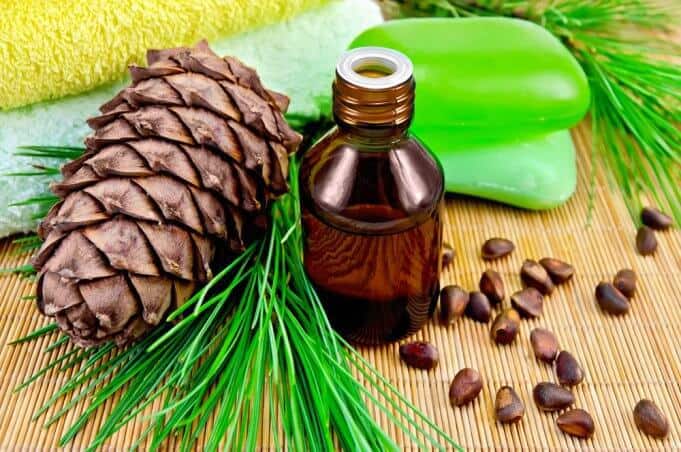
They have their uses but for this reason, the more holistic approach prefers essential oils. Having said that, absolutes do hold their place within aromatherapy and natural fragrance applications. Just as with steam distilled essential oils, absolutes should be used cautiously and with knowledge. Obviously if one was practicing internal use, the preference would be essential oils since one wouldn’t want to use an oil internally that contains trace amounts of solvents. Although absolutes are not recommended for internal use, they still have excellent therapeutic uses.
Jasmine grandiflorum (Jasminum grandiflorum) absolute’s therapeutic actions include holistic treatment for apathy, hysteria, uterine disorders, childbirth, muscle relaxation, and coughs. (11)
Essential Oil Categorization
There are a few ways we can categorize essential oils. Here we’ve listed the plant parts used for essential oils. This is not an all-inclusive list nor does it specify chemo types or species, which is relevant to the safety of each oil. This is to give a general idea what parts of a plant are used for essential oils.
Plant Parts Used
Cones | Rind of the Fruit | Fruit |
Cypress | Bergamot | Juniper Berry |
Siberian Fir | Grapefruit | Grass |
Dried Fruit | Lemon | |
Lime | Ginger Grass | |
Sugandha Kokila | Makrut Lime Peel | |
Xanthoxylum | Mandarin | |
Orange | ||
Yuzu |
Needles | Resin | Rhizomes |
Fir | Balsam Copaiba | Gandhi Root |
Hemlock | Elemi | Ginger |
Pine | Frankincense | Plai (Central) |
Spruce | Myrrh | TurmericGinger Grass |
Opopanax | ||
Peru Balsam |
Buds | Leaves | Twigs |
Balsam Poplar | Basil (Sweet) | Balsam Fir |
Cape Chamomile | Bergamot Mint | Cajeput |
Clary Sage | Cajeput | |
Cinnamon Leaf | Engelmann Spruce | |
Flowers | Clary Sage | Fragonia |
Basil | Clove Bud | Hemlock |
Blue Tansy | Cypress | Ho Leaf |
Chamomile | Davana | |
Davana | Kunzea | |
Helichrysum, Gymnocephalum and Italicum | Eucalyptus | Larch Tamarack |
Honey Myrtle | Fragonia | Manuka |
Hyssop ct 1,8-cineole | Niaouli ct-1,8 cineole | |
Inula (sweet) | Guava Leaf | Norway Pine |
Jasmine Absolute | Kanuka | Ponderosa Pine |
Lavender | Kunzea | Rock Rose |
Lemon Thyme | Laurel Leaf | Rosalina |
Marjoram (Sweet) | Lemon Myrtle | Rosemary ct camphor |
Manuka | Scotch Pine | |
Neroli | Sweet Marjoram | Utah Juniper White Fir |
Petitgrain | Mastic | |
Rose | Melissa | |
Rosemary ct. Verbenone | ||
Spike Lavender | Rosalina | |
St. John's Wort | Rosemary | |
Thyme | Saro | |
Tulsi (holy basil) | Spearmint | |
Yarrow | Tea Tree | |
Ylang Ylang | Thyme | |
Wintergreen | ||
Yarrow |
Notes (Evaporation Rates) of Essential Oils
Another way to categorize your oils is by “note,” which is determined by the evaporation rate of the oil.
The first smell from a blend and the first to evaporate is your essential oils with the top note. The top note fragrance is usually lighter with a beautiful fresh aroma. These oils add brightness to your blend. Some examples of top notes are distilled lime, bergamot, lavender, eucalyptus, grapefruit, and orange.
The next note is the “heart” note, better known as the middle note. It gives blends an aromatic softness and fullness to their overall aroma. Some middle notes can be top-middle or middle-base, meaning they have notes of the top or base aromas within them. They absolutely harmonize your blend as you will notice when you learn the middle notes. These oils are your mentally and physically calming and soothing oils. Great middle notes include Roman chamomile, lavender, ravintsara, rosewood, clary sage, ylang ylang, jasmine, and many more.
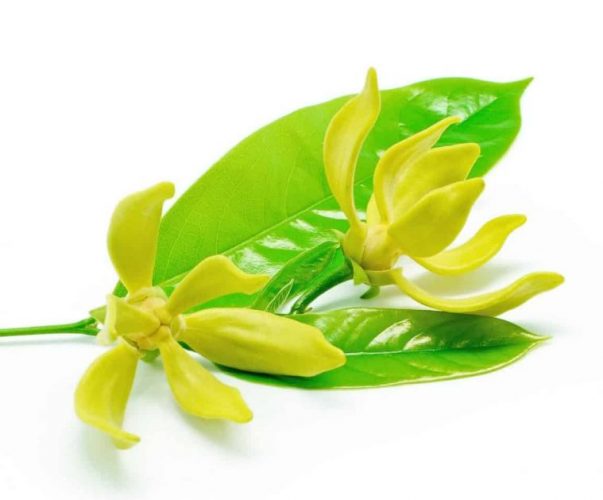
Last is the base note. These are the oils that provide that deep, warm, and grounding quality to your blend. They function as fixatives by reducing the evaporation rate of the top notes. Base notes add a deepness to the blend and more often than not they have beautiful, deep, and earthy aromas. Because of their calming and grounding qualities, base notes are your relievers of stress, anxiety, and insomnia.
Several of the essential oils derived from woods, resins, and roots are base notes. Ylang ylang is an exception. It is a base-middle note and falls under both categories. It’s derived from the tree’s beautiful, white, fragranced flower. Base notes are so soothing and harmonizing for the mind and body. Some great base notes include cedarwood, patchouli, vetiver and myrrh.
When blending top, middle, and base notes, your overall aroma will change over time as the evaporation takes place. You may pick up the citrus aroma at first then later it may be the middle notes that stand out. It is remarkable how the aroma changes, yet still has the lingering scent of the top notes. (12)

So how do we blend these notes? Oils in the same category tend to blend well together. Florals blend well with spicy, citrusy, and woodsy oils. Woodsy oils generally blend well with all categories. Spicy and oriental oils blend well with florals, oriental, and citrus oils. Be careful not to overpower the blend with the spicy or oriental oils.
Minty oils blend well with citrus, woodsy, herbaceous, and earthy.
Essential oils can be categorized into broad groups based on their aromas. An example categorical system is as follows:
- Citrus – Grapefruit, Lemon, Lime, Mandarin, Orange
- Earthy – Oakmoss, Patchouli, Vetiver
- Floral – Chamomile, Jasmine, Lavender, Neroli
- Herbaceous – Basil, Plai, Rock Rose, Rosalina, Rosemary, Sweet Marjoram
- Medicinal/Camphorous – Cajuput, Engelmann Spruce, Eucalyptus, Pinion (Pinyon) Pine, Tea Tree
- Minty – Peppermint, Spearmint, Tulsi, Wintergreen
- Oriental – Ginger, Patchouli
- Spicy – Clove, Cinnamon, Nutmeg
- Woodsy – Cedars, Fir, Pine, Spruce
Applications of Essential Oils
Diffusion
There are many diffusers available these days that are specially made for essential oils, from units designed for homes, cars and even ones you wear. Diffusion works by distributing essential oil molecules through the air. Once in the air, they are inhaled and come into contact with nerves that send them directly to the brain. This is a quick and safe way of letting the essential oils go to work for you.
An alternative to the use of a diffuser is direct inhalation. Inhalation plays a huge role in aromatherapy and presents a very low risk to most people. During inhalation, odor molecules travel through the nose and affect the brain through a variety of receptor sites, one being the limbic system, which commonly is referred to as the emotional brain.
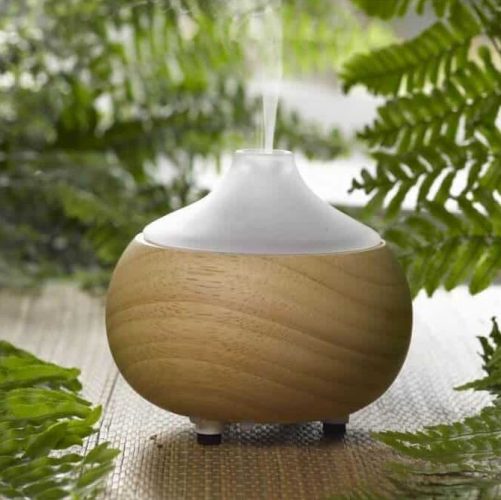
The limbic system is directly connected to those parts of the brain that control heart rate, blood pressure, breathing, memory, stress levels, and hormone balance (Higley & Higley, 1998). This relationship helps explain why smells often trigger emotions. With this information we can hypothesize how inhaling essential oils can have some very profound physiological and psychological effects. Also while inhaling, the oils pass down the trachea into the bronchi, and down to the lungs. More details on this process can be found in Tisserand and Young, Essential Oil Safety, 2nd edition, page 49.
After essential oils reach the bloodstream, they enter the central nervous system (CNS) quite easily. With this being the case, it’s imperative that we safely use essential oils. This easy access to the CNS can pose serious issues and complications when essential oils with cautionary concerns are ignored, especially when it comes to our children.
On diffusion and children, Tisserand states, “A few drops of essential oil in a burner, vaporizer, or in a steam inhalation is virtually risk-free. However, prolonged inhalation (more than about 30 minutes) of concentrated essential oils vapors (e.g. steam inhalation, or direct from a bottle) can lead to headaches, vertigo, nausea, and lethargy. In certain instances, serious symptoms might be experienced, such as incoherence and double vision.”
Tisserand continues, “For children of 5 years old or less, direct inhalation should be avoided. Direct inhalation includes inhaling essential oils from the hands, a cotton ball, a nasal inhaler, a bowl of hot water, or similar. Indirect, or ambient inhalation, is safe for young children, and includes any method that vaporizes essential oils into the air.” (13)
Diffusion is safe when we follow some safety guidelines. Diffuse essential oils for no more than 30-60 minute intervals with a 10-minute break. Although this is a safe method of application, when diffusing for children we should still take into consideration the age (do not diffuse around premature infants), the health (especially presence of asthma), the child’s weight, and any medications involved. The diffusion method doesn’t erase the importance of any individual oil safety precautions. Some essential oils, no matter what method, are not safe for children so please seek advice from a reputable source on essential oil safety. (14)
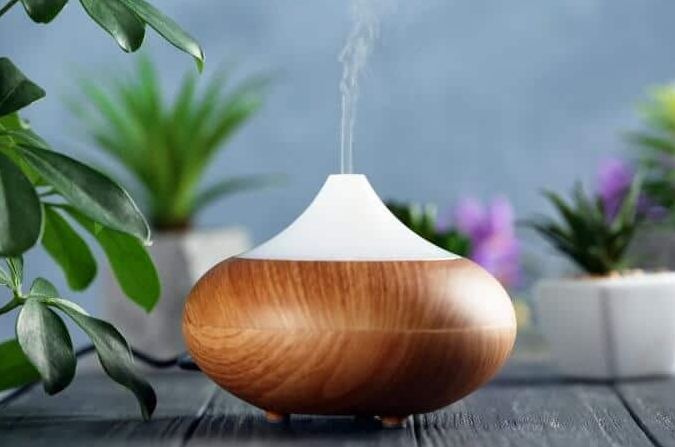
I’ve worked my way through Tisserand and Young’s 2nd edition of Safety of Essential Oils book; the one book I refer to when it comes to safety for children. If you purchase this book, I encourage you to read through it before any diffusing. Not one section, chapter, or page will have all the information that is needed to accurately and safely use your essential oils in one convenient place. Research is key.
I asked the author for a more definitive answer on diffusion with children. From Robert Tisserand: “I think after 3 months is OK, so long as diffusion is not too intensive. I know that’s vague, but air concentration of volatiles is hard to pin down, and even if we could – there’s no clear guideline.” Inhalers would fall under “direct inhalation” and should be avoided for those 5 and under. With safety in mind and since each child is an individual with their own weight, health, and age, apply your Mommy instincts for your own child/children. I always recommend looking for scientific based research as listed below.
Topical/Dermal Use
The most important aspect of essential oils is how to use them safely, especially with children. Because of this, we will concentrate on children when it comes to dermal dosing. Adult dosing can be derived based on the chart below.
Once again, apply your Mommy instincts. Always look up individual safety guidelines for each essential oil as some are not meant to be used topically on children.

Be especially aware that a great deal of caution should be used with topical application on infants since their skin does not mature until around three months. Infant’s skin is not only more sensitive to essential oils, the absorption rate is higher because the skin is more permeable. Premature infants should always be excluded from any amount of dermal use.
Bathing children with essential oils requires a great deal of discretion, however it can be done safely. Use 1 ounce of a water-soluble medium to blend with (jojoba oil is a favorite for this purpose) and 9 drops of lavender (Lavandula angustifolia). Add no more than ½-1 tablespoon to bath, depending on how full you run the bath. Then your little one can enjoy a relaxing bath before nighty-night time.
Lavender serves so many purposes and it really is a perfect essential oil for children. However, even with lavender, it’s still important to do a skin patch test since there has been noted an occasion of irritation from lavender. With multiple therapeutic properties including anti-inflammatory, anti-bacterial, analgesic, sedative, respiratory support and more, this is my go to for children.
For topical use, Tisserand suggests the following:
“Age-related recommended and maximum concentrations of essential oils for massage”
Age | Recommended (%) | Maximum (%) |
Premature infant | 0 | 0 |
Up to 3 Months | 0.1 | 0.2 |
3-24 months | 0.25 | 0.5 |
2-6 | 1.0 | 2.0 |
6-15 years | 1.5 | 3.0 |
15 + years | 2.5 | 5.0 |
Tisserand states that these concentrations aren’t researched based. These are, however, safety suggestions from one of the top experts in the industry. (15)
In both children and adults, different factors can affect the absorption of essential oils through the skin. Warming the area up first with either a warm cloth (if wet, dry thoroughly) or heating pad, then massage the area, will increase the circulation to that area which in turn will allow more absorption of the essential oils.
As to how much is absorbed into the body is determined by several factors. First how much is used and the total dilution rate. The next thing to consider is how they are dispersed, what is the overall area of the body being applied to, the health of the skin and the age of your client. As mentioned above, the temperature also affects the absorption and this can increase by adding a warm cover over the skin after oils are applied. And of course, what essential oils you choose affects the final outcome.
You can find other useful information and guidance at NAHA (National Association for Holistic Aromatherapy) at http://naha.org.
Internal Use of Essential Oils
Internal use of essential oils has become more and more frequent by the untrained, adding to the mound of injury reports. We avoid discussing the topic, sending our readers off with “do not ingest,” or “consult a trained Clinical Aromatherapist, one trained in aromatic medicine,” or other direction or reason to avoid the discussion of ingesting.
Some, like myself, have studied for years, come from a medical background, and have an understanding of ingestion but, because we are not formally trained, we don’t speak of ingesting. So what are people doing? They will seek out answers, whether it is through MLM companies and reps, their friends, or what they can find on the internet.
People either then ingest privately or they are very public about it, encouraging others to follow suit, with no knowledge of the chemistry of good and bad components within essential oils. Most of what we hear and read about ingesting essential oils from the untrained is wrong, unsafe, and dangerous.

There are both harmful and protective therapeutic chemicals within oils. How harmful depends on the individual oil and the person. The “one shoe fits all” scenario does not apply. To avoid risk of a toxic reaction, you need to know the susceptibility of an individual.
To understand the susceptibility, you need to know the age, body weight, health (including those with chronic illnesses or pregnancy), blood pressure, and medications related to the individual. Even hereditary traits should be taken into consideration. There are many essential oils that are never used internally due to concern of either toxicity or mucous membrane damage.
Many components (constituents) within some oils are mucous membrane irritants and, whether delivered in the proper dosing vehicle or not, or in large doses, the essential oil can become unsafe rather than having a healing effect. Large doses brings risk of irritation to your gastric tract or any mucous membranes they come into contact with. Some oils contain components that can affect blood coagulation, some exert hypoglycemic effects, etc.
Armed with proper training, many oils are quite safe taken internally. A part of that training is essential oil pharmacokinetics and pharmacodynamics. To learn more on ingestion, you can visit my website. (16)
Chemistry of Essential Oils
Essential oils consist of many organic molecules made of hydrogen as well as carbon and some oxygen, dependent on the essential oil. Essential oil molecules are made of chemical families such as monoterpenes, monoterpenols, sesquiterpenes, sesquiterpenols, oxides, aldehydes, esters, ethers, ketones, and phenols. It is within these chemical families that you find the components. There can be one or more chemical family within each oil.
What makes each essential oil unique is the constituents. Some constituents found in essential oils that range in safety include b-myrcene, a-pinene, b-pinene, camphor, camphene, linalool, d-limonene, linalyl acetate, and geranyl acetate – and these are only some of the top noted constituents. Components of concern in essential oils include cinnamaldehyde, eugenol, thujone, thymol, and menthol.

Used incorrectly, these components can cause sensitization or, worse, severe burns. Each constituent has been scientifically studied, researched, and documented and been shown to have various therapeutic actions such as analgesic, anti-inflammatory, anti-bacterial, anti-depressant, sedative, or various other properties. Research has shown oils to affect our moods, emotions, and overall physical well-being. (17)
Related Article: Why Can’t I Sleep?
What molecules are within the oils determines the therapeutic actions of the oil. Below are examples of the constituents’ a-pinene and b-pinene. They are made of carbon and hydrogen, but note the slight differences in the two. Because of this difference, they therapeutically work slightly differently. A-pinene is an anti-inflammatory, antibacterial, antifungal (candida), antispasmodic, antiviral, and prevents bone loss whereas b-pinene is an anti-inflammatory, antioxidant, antispasmodic, and prevents bone loss. (18)
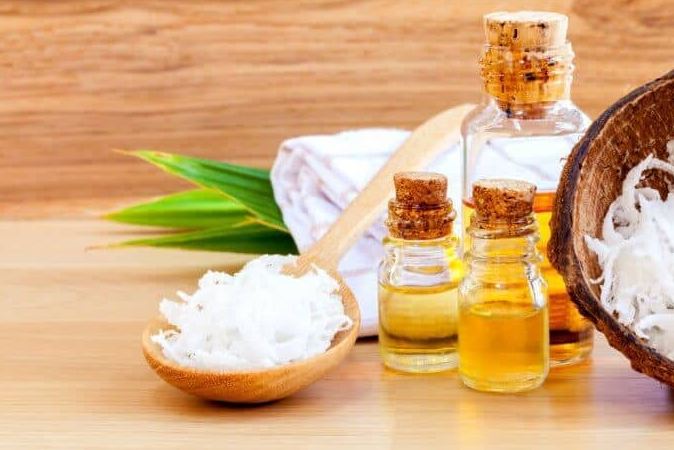
Whether chemistry is by nature or synthetic, safety is always a concern and this applies to essential oil chemistry as well. Oils high in constituents such as phenols are going to be very irritating whereas oils made of sesquiterpenes are gentle loving oils to the skin. Learning the chemical family and safety of each individual oil means less injury and more effective treatment. There are many resources for learning essentials oils and safety. We recommend taking one oil at a time, research, and then move on to the next.
Carrier Oils
Carrier oils are made from plants and can include nuts, seeds, or fruits. Some carrier oils include coconut oil, olive oil, sweet almond oil, argan oil, and jojoba oil (although this is really a wax). They aren’t volatile like essential oils are. They tend to be heavier than essential oils and are very safe for the dermis (inner skin).
Essential oils can irritate skin and cause serious reactions including dermatitis. Carrier oils are used as a diluting agent to help prevent a reaction. This does not dilute the effect or power of the essential oils, and in fact helps to bind the essential oils. This keeps essential oils from evaporating so quickly, allowing time for the oils to absorb into the dermis more efficiently.
1. Aloe Vera: Great for prematurely aging, sensitive, or inflamed skin. I’ve used this successfully on poison ivy.
2. Apricot Kernel CP (cold pressed): Wonderful on prematurely aging, sensitive, or inflamed skin and it absorbs easily.
3. Argan: Similar to sweet almond in that it is great for all skin types, especially those who have sensitive skin or are prone to eczema and it is very soothing. I also love this for my hair. Take a small amount and work into your hair. It disappears without an oily feel. Argan goes well with bergamot essential oil for dermatitis and cedarwood essential oil for itch relief, dandruff, and eczema.
4. Arnica Infused Oil: Arnica is often applied externally on unbroken skin to treat sore muscles and joints as well as bruising, sprains, and strains. Try making a salve for arthritic conditions. Arnica is a rubefacient meaning it does its work by bringing more blood to the injured area, causing a slight irritation.
5. Avocado: avocado is very healing because it’s deeply moisturizing and safe for all skin types, and acts as an anti-bacterial and an anti-wrinkle.
6. Babassu Oil: Interchangeable with Coconut Oil in most recipes as it is just as moisturizing and nourishing. It is an especially beautiful restorative agent for the skin and scalp. The oil readily melts at body temperature such as when rubbed onto hands; it is soothing, acting as an emollient.
7. Baobab Oil: Highly penetrating, deeply nourishing, and softens dry skin. It is known to restore and moisturize the epidermis. Absorbs easily and quickly; improves the skin’s elasticity & tone; cell regenerator; relieves Eczema and Psoriasis. Alleviates pain from burns and regenerates epithelial tissue quickly. It is extremely stable and provides a fairly good measure of unsaturated and saturated fats.
8. Calendula Infused Organic Oil: Anti-inflammatory, wound healing (cicatrisant – especially stubborn wounds); use for varicose veins, skin infections, cuts, punctures, scrapes, burns, and chapped skin or lips.
9. Carrot Seed Oil: Another great oil for premature aging, itching, burning, dryness, psoriasis, eczema, rejuvenating the skin, and reducing scarring.
10. Cranberry Seed Organic Oil: Anti-inflammatory, moisturizing, relief from hot skin conditions such as eczema, psoriasis, and rashes, broad-spectrum UV-protectant, antioxidant.
11. Coconut: Conditioning, protectant, spot treatment for acne, wound healing, helps keep other carrier oils from going rancid.
12. Emu: Emu is 100% triglyceride which equals nearly a complete neutral lipid. Excellent for muscle and joint aches. Results are remarkable.
13. Organic Hemp Seed Oil: A cold-pressed and unrefined anti-inflammatory, used for healing skin infections, has antioxidant properties, moisturizing for the skin, skin protecting, and culinary purposes.
14. Jojoba: Protects the skin but allows it to breathe. Helps control acne and is a wonderful antioxidant.
15. Kpangnan (pronounced like pon-yah): Remarkably more moisturizing than shea butter and, when applied to the skin, has a slight warming effect. Studies have found that kpangnan contains a high amount of stigmasterol, an unsaturated plant sterol that contains anti-inflammatory and pain relieving agents. Organic and unrefined will give you the best butter for skin preparations. As soon as it is refined it changes its wonderful skin healing properties. The butter should be hard and yellow.
16. Marula Oil (wild crafted): serves as a fantastic carrier oil and is beautiful with a delicate aroma and light yellow color. Rich in oleic acid, marula is hydrating and can help increase epidermal smoothness. Known to protect and nourish the skin, good for oily skin and hair, relieves Dermatitis, Eczema, and Psoriasis. It helps heal sunburns and chapped/irritated skin. It’s a great antioxidant and can be used around the eye area for fine line treatment. It’s got antibacterial action – used to treat wounds and burns – and has free-radical scavenging properties.
17. Neem: Anti-bacterial, anti-inflammatory, fungicide, conditioning, restores skin, antiseptic, and insecticide; great for psoriasis, skin diseases, herpes, allergies, itching, and sunburns. Neem has many benefits, but be warned that it has a very strong scent that can overpower the scent of an essential oil.
18. Olive Oil: Conditioning, cleansing, softening, absorbs well, and is an antioxidant.
19. Rose Hip: Love this oil. Remarkable for damaged, irritated skin. Also good for dry, mature skin.
20. Shea: Shea feels elegant to the skin, is anti-inflammatory, and is used for dry skin, eczema, and more.
Blending Guidelines for Essential Oils
We touched on dilution rates for children. The following dilution rates are for adult, healthy skin.
| For 1 oz. (30 ml) of carrier | For 2 0z. (60 ml) of carrier |
|---|---|
| 1% dilution: 9 drops total | 1% dilution: 18 drops total |
| 2% dilution: 18 drops total | 2% dilution: 36 drops total |
| 3% dilution: 27 drops total | 3% dilution: 54 drops total |
When you are blending, you will find your mixtures are amazing by considering the following:
- Aroma preferences: The aroma and notes of oils; i.e. top, middle, and base notes. In between these are top-middle and middle-base.
- What carrier you will use (olive oil, coconut oil, sweet almond, jojoba wax, unscented lotion)
- Concerns and goals of you or your client
- Chemistry of the oils (chemical family, chemical components)
- Method of application; topical, diffused, inhaler, etc.
- The energetics of oils
- Is it for an acute or chronic issue, relaxation, mood enhancing
- Safety concerns of the individual oils used
While deciding which oils to use, smell each one. Andrea Butje at Aromahead Institute recommended using coffee beans to clear your “aroma” palate. Sniff the beans to “clear the palate” before smelling the next and so on. I tried it and it works great.
We often hear about “synergy” blending or buy oils with this on the bottle, but what does it mean? Synergy is the “expression of the whole has greater effects than the sum of all its individual parts.” We can create this synergy with essential oils by combining two or more in the same blend.
Component Blending:
An example of component blending is Eucalyptus citriodora. Its antimicrobial effects are due to a synergy between citronellal and citronellyl. Research shows that each component on its own is four times less effective than when combined. I use this method when I’m blending for medicinal purposes like colds, sinus infections, flus, sore throats, allergies, body aches, pains, and inflammation. I use pines, spruces, firs, and cedars when component blending for pain, inflammation, or respiratory issues. Nice additions to conifers are plai, copaiba, or cannabis essential oil.
Essential Oils Synergy:
When blending, knowing the chemical family is important. For synergy blends, it’s good to try to blend a few oils from the same chemical family to achieve a good solid foundation. But don’t over do it. Find a balance. Keep in mind that although the major components play an important role in an essential oil, it is the oil as a whole that makes it therapeutically effective.
Shelf Life of Essential Oils
The shelf life for each of the products you make varies depending on the ingredients you add to the blend. If you are blending three different carrier oils, the shortest life of the three becomes the shelf life of your product. This holds true for your essential oils as well; you use the shortest shelf life.
Each oil has its own shelf life. If your supplier does not provide the shelf life, websites such as Aromaweb.com do and is an excellent resource. When you purchase your oils and open the bottle for the first time, this starts your shelf life. Writing the date on the bottle when it is opened for the first time is a great way to track your shelf life.
If you are creating hydrous blends or blends with water based ingredients such as hydrosol and water sprays, aloe vera gels, or castile soap blends with water added, they will last only a few weeks so keeping these in the refrigerator is best. Adding a preservative is great when water is one of your ingredients because it will extend the life of your product.
A good practice is to keep track of every ingredient you buy, when it was produced, and the length of the shelf life. Essential oils are best stored in a cool place around 60-65 degrees. I find a mini fridge works quite well. When first into oils, I stored mine in my regular refrigerator in a glass-covered container. Within a few weeks, my milk smelled and tasted like essential oils. Although I love my oils, I found they don’t go well with milk. Store then in a separate refrigerator to avoid this aromatic and gustatory experience.
Ensure all oils are tightly closed to avoid oxidation and shortening the shelf life of your oil. Any company you buy from should have the distillation date on their products. This is vital to a great product.
The following is an example of a blend that would have the shelf life of the avocado oil used.
- 1 0z. (30 ml) Jojoba wax (generally does not go rancid)
- 1 0z (30 ml) Avocado oil (about one year of shelf life from when it was produced)
- 20 drops Jasmine absolute essential oil (about 4-5 year shelf life)
So, if the avocado oil was produced in the beginning of August and stored in a cool place and bought it in January, it was about 6 months old when you purchased it so now its remaining shelf life is 6 months.
Aloe vera gel is in its own unique category. When you purchase it from a supplier it’s usually preserved already. If you add only essential oils, you will likely be able to use the shelf life of the aloe. However, if you add additional ingredients, especially those that are water based (water or hydrosols), it throws off the balance of the preservative and now the shelf life has changed.
Purchasing Essential Oils
When purchasing oils, one needs to be aware of the product and exactly what they are purchasing. Some companies will dilute the oils with additives or add synthetic impurities to their oils. Some examples of synthetic ingredients that are put in essential oils are alcohol, oils of lesser value, and certain synthetic esters (such as soap from animal fat or gelatin).
The quality of the oil is evident in the analysis reports that some companies provide. The GC/MS (Gas Chromatography/Mass Spectrometry) analysis reports ensure quality control. Comparing 3-4 reputable companies allows you to choose the best quality of oil. Even if you cannot interpret these reports you can compare the numbers side by side. The higher percentage, the better quality.
Where to Buy Essential Oils
Unbiased, professional recommendations on where to buy high quality essential oils
Oils are often adulterated in one way or another and even though you may not be trained to interpret these reports, any company that trusts that their oils are pure and beautiful will have these reports readily available; this shows confidence in the purity of their oils.
It’s the companies that do not offer these or give you explanations about “costs,” “too time consuming to upload,” and other invalid excuses that I avoid. It’s also good to find a company that uses outside labs to test their oils.
If you need assistance with weeding out the bad companies, utilize groups on Facebook that work as watchdogs for fraudulent oils. EOCR (Essential Oil Consumer Reports) group is one and Essential Oil Analysis Foundation operated by Dr. Robert Pappas is another resource. Dr. Pappas tested oils from various popular department stores. All the oils tested failed. His analysis reports can be found at his website. Two popular MLM companies are on the list of failed oils, along with several other companies.
Check the botanical name of the plant used to make the essential oil to make sure you are getting what you want. There are quite a few oils that are made from different but similar plants and sold under the same name. For instance, Chamomile can be Roman chamomile (Anthemis nobilis) or German chamomile (Matricaria chamomilla).
A few companies that are trusted for their quality, sustainability, customer service and transparency are Edens Garden, Rocky Mountain Oils, Plant Therapy, Nature’s Gift, and Stillpoint Aromatics.
Essential Oil Blend Recipes
Note: Before using any blend, always do a skin patch test by applying a small amount of your diluted blend on the inside of your forearm or where skin is thinnest. If no reaction within 10 minutes, you should be safe to use.
Calm and Center:
- 3 drops Lavender Lavendula angustifolia
- 6 drops TangerineCitrus tangerina
- 2 drops Vetiver Chrysopogon zizanioides
- 8 drops Vanilla Oleoresin
- 2 oz. unscented lotion or carrier oil
This is great for the overexcited child. Its gentle oils help to calm and focus.
Restful Nights:
What better recipe to have than one that can help achieve a good night’s rest.
- The following is perfect for just that.
- 4 drops Sweet Marjoram Origanum majorana
- 4 drops FrankincenseBoswellia carterii
- 5 drops Lavender Lavendula angustifolia
- 5 drops Vetiver Chrysopogon zizanioides or Ruh Khus Vetiveria zizanioides
- 1 oz. Unscented lotion or carrier oil. This blend can also be added to an inhaler.
Related product: GroundLuxe Earthing Sheets
For an uplifting and bright start to the day, grab your essential oil diffuser and add 10 drops grapefruit essential oil and 5 drops sweet orange. In addition to being energizing, citrus oils are dominant in d-limonene, a component excellent for fighting of viruses, bacteria, and infections as well as airborne microbials.
Safe recipes for the whole family
Anxiety (Momma’s love)
- 3 drops Lavender Lavendula angustifolia
- 2 drops Clary Sage Salvia sclarea
- Add to 1 teaspoon vegetable oil. Apply to wrists, neck or wherever you prefer.
Beautiful Relaxing Body Lotion (adult)
- 20 drops Frankincense Boswellia carterii
- 8 drops Lavender Lavendula angustifolia
- 10 drops Jasmine absolute Jasminum grandiflorum
- 8 drops Cedarwood Juniperus virginiana
- 5 drops Rose Otto Rosa damascena
- Combine and add 27 drops to one ounce unscented lotion or Jojoba oil.
Cough and Congestion (blend with carrier or diffuse) (family friendly)
- 10 Drops Cedarwood Juniperus virginiana
- 15 Drops Tea Tree Melaleuca alternifolia
- 5 Drops Frankincense Boswellia carterii
- 10 Drops Lavender Lavendula angustifolia
- 10 Drops Lemon Citrus limon
Note: Cedarwood (Juniperus virginiana) is one of the most effective essential oils in treating coughs and respiratory concerns for any age. Tea tree is one of the best airborne antimicrobial and antivirals, as well as having other therapeutic effects.
Frankincense is a huge immunostimulant plus, and I’d put lavender because its main constituent is linalool which makes it a great analgesic oil. Because of the constituent d-limonene, around a high of 70%, lemon is an excellent anti-viral, anti-inflammatory, antibacterial, anti-depressant, antioxidant, immune stimulant, and perfect with blends because it enhances skin penetration.
Essential Oil Safety
Some More Safety Considerations
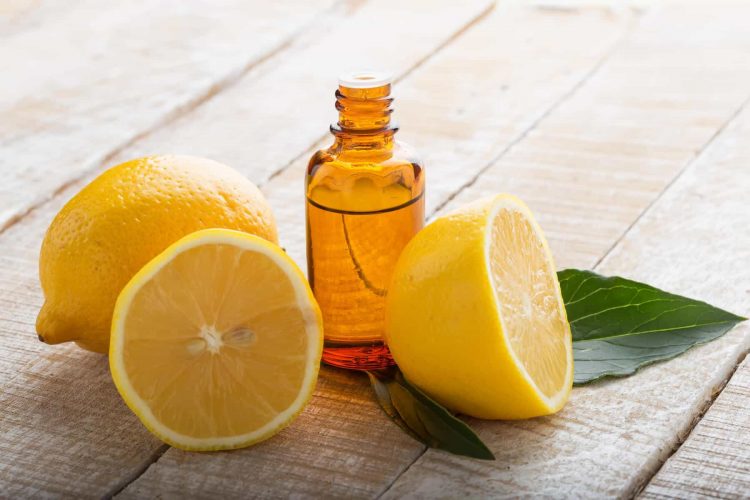
- Blood Pressure: Tisserand states there are no contraindications with topical use.
- Respiratory Issues: Caution if you have asthma, allergies, or other respiratory issues.
- Seizures: If someone has or is suspected of seizures, it is best to avoid the following oils: Birch, Buchu, Calamint, Feverfew,Ho Leaf, Hyssop, Lavandin, Rosemary, Spike Lavender, Tansy, Wintergreen, Yarrow Mugwort (20)
- Pregnancy and Breastfeeding: Caution should be taken during this precious time. There are approximately 50 essential oils that are contraindicated during pregnancy and 15 that should be completely avoided. For safe essential oils, it’s recommended to blend no more than 1% for topical use and under the guidance of a qualified Aromatherapist. (21)
- For children from 5-12 years of age, elderly, pregnant and those with serious health issues, dilute no more than 1%, or 9 drops per ounce, of carrier oil.
- For children under five years old, we recommend hydrosols and carrier oils. For booboos, an occasional use of lavender is ok. Further recommendations for children were previously mentioned.
- Essential oils should never be used on animals. They do not metabolize essential oils as we do. Our recommendation is to seek advice from Kelly Holland-Azzaro, Animal Aromatherapist, Clinical Aromatherapist, and Author/Writer/Researcher on Facebook at Animal Aromatherapy (Safe Use) and at NAHA.
- Phototoxic Oils: If applying the following oils at a higher percentage than what is recommended, sun or sunbeds should be avoided at least 12-18 hours after application to avoid risk of phototoxicity. However, Tisserand states that if you follow the suggested safe maximum levels, there is no risk. Angelica root (0.8%), Bergamot (0.4%), Cumin (0.4%), Grapefruit expressed (4.0%), Laurel leaf absolute (2.0%), Lemon expressed (2.0%), Lime expressed (0.75), Mandarin leaf (0.17%), Orange bitter expressed (1.25%), Rue (0.15%), Taget oil or absolute (0.01%). (22)
- Do not use oils around or near eyes, nose, ears, or any other mucous membranes. If oils come in contact with these, immediately wash out with carrier oil. DO NOT USE WATER. If irritation continues, seek medical attention. (pg. 658 Tisserand and Young)
- Because of possible or unknown effects on the immune system, Tisserand recommends not using essential oils at least 1 week before and 1 month after chemotherapy (pg. 656 Tisserand and Young).
- Most injuries with children happen with they get their hands on essential oils. Please store your essential oils out of reach of children or in a locked cabinet.
Essential Oils that Irritate Skin
The lighter your skin, then more sensitive it can be. Keeping in mind that the maximum recommendations are for healthy, undamaged adult skin, oils vary from no topical safe use at all to limited irritation. It’s important to check individual oil safety (See sensitization, Tisserand and Young, pg. 77).
Lastly, if you want more information on each individual essential oil, see our master list of essential oils and their properties.
References:
- https://www.researchgate.net/publication/13081715_Lavender_Oil_Inhibits_Immediate-type_Allergic_Reaction_in_Mice_and_Rats
- Mojay, G. (1999). Aromatherapy for healing the spirit: Restoring emotional and mental balance with essential oils. Rochester, VT: Healing Arts Press; Lavender, pg. 90-91
- Tisserand, R., & Young, R. (2007). Essential oil safety: A guide for health care professionals (2nd ed.). New York, NY: Churchill Livingston; Lavender; pg. 325-327
- https://www.researchgate.net/publication/13081715_Lavender_Oil_Inhibits_Immediate-type_Allergic_Reaction_in_Mice_and_Rats
- Kagawa D, Jokura H, Ochiai R, Tokimitsu I, Tsubone H (2003) The sedative effects and mechanism of action of cedrol inhalation with behavioural pharmacological evaluation. Planta Medica 69: 637-641
- Tisserand, R. and Young, R. (2007) Essential oil safety; A guide for health care professionals (2nd Ed.). NY: Churchill Livingston; Absolutes, pg.
- Tisserand, R. and Young, R. (2007) Essential oil safety; A guide for health care professionals (2nd Ed.). NY: Churchill Livingston; Isolation, pg. 6
- The Practice of Aromatherapy; Dr. Valnet, Jean; Ed. By R. Tisserand; Steam distillation oils
- Tisserand, R. and Young, R. (2007) Essential oil safety; A guide for health care professionals (2nd Ed.). NY: Churchill Livingston; Concretes, pg. 7
- Tisserand, R. and Young, R. (2007) Essential oil safety; A guide for health care professionals (2nd Ed.). NY: Churchill Livingston; Essential Oil Profiles, pgs. 187-482
- Jasmine Absolute grandiflorum https://www.ncbi.nlm.nih.gov/pubmed/12203263
- https://en.wikibooks.org/wiki/Complete_Guide_to_Essential_Oils/A_to_Z_of_essential_oils
- Tisserand and Young, Essential Oil Safety, 2nd ed. pg. 49. Diffusion
- Tisserand, R. and Young, R. (2007) Essential oil safety; A guide for health care professionals (2nd Ed.). NY: Churchill Livingston; App. A Clinical Safety A-Z pg. 658-659
- Tisserand, R. and Young, R. (2007) Essential oil safety; A guide for health care professionals (2nd Ed.). NY: Churchill Livingston; pg. 47 Dermal Dosing Children
- https://www.soulessentialsduo.com/single-post/2017/10/02/Ingestion-of-Essential-Oils-Cautiously-Approached-by-Rehne-Burge-CA
- (n.d.). Retrieved October 06, 2016, from https://www.ncbi.nlm.nih.gov/pubmed/23531112; Aromatherapy and the central nervous system (CNS)
- (n.d.). Retrieved August 23, 2016, https://www.ncbi.nlm.nih.gov/pubmed/26434146 a-pinene effects
- https://www.soulessentialsduo.com/single-post/2017/02/15/Carrier-Oils-and-Descriptions
- Tisserand, R and Young, R (2007) Essential oil Safety; A Guide for Health Care Professionals (2nd Ed). NY: Churchill Livingston; p.134, table 10.2
- Tisserand, R and Young, R (2007) Essential oil Safety; A Guide for Health Care Professionals (2nd Ed). NY: Churchill Livingston; Charts Pages; 152, 153 and 156
- Tisserand, R and Young, R (2007) Essential oil Safety; A Guide for Health Care Professionals (2nd Ed). NY: Churchill Livingston; Sunlight/sunbeds Pg; 659
Further Resources:
- http://naha.org/explore-aromatherapy/about-aromatherapy/how-are-essential-oils-extracted/
- https://www.ncbi.nlm.nih.gov/pubmed
- https://pubchem.ncbi.nlm.nih.gov/
- https://www.sciencedirect.com/
- Robert Tisserand and Rodney Young; 2nd Ed. Essential Oil Safety, Churchill Livingstone Elsevier
- Gabriel Mojay; Aromatherapy for Healing the Spirit, Restoring Emotional and Mental Balance with Essential Oils
- Sylla Sheppard-Hanger; The Aromatherapy Practitioner Reference Manuals
- Dr. Jean Valnet, The Practice of Aromatherapy, edited in English by Robert Tisserand
| Cones | Rind of the Fruit: | Fruit: |
|---|---|---|
|
|
|
| Needles: | Resin: | Rhizomes: |
|---|---|---|
|
|
|
| Ripe Fruit: | Roots: | Seed Pod: |
|---|---|---|
|
| Seeds: | Trunk: | Wood: |
|---|---|---|
|
|
| Buds: | Leaves: | Twigs: |
|---|---|---|
|
|
Notes (Evaporation Rates) of Essential Oils
Another way to categorize your oils is by “note,” which is determined by the evaporation rate of the oil.
The first smell from a blend and the first to evaporate is your essential oils with the top note. The top note fragrance is usually lighter with a beautiful fresh aroma. These oils add brightness to your blend. Some examples of top notes are distilled lime, bergamot, lavender, eucalyptus, grapefruit, and orange.
The next note is the “heart” note, better known as the middle note. It gives blends an aromatic softness and fullness to their overall aroma. Some middle notes can be top-middle or middle-base, meaning they have notes of the top or base aromas within them. They absolutely harmonize your blend as you will notice when you learn the middle notes. These oils are your mentally and physically calming and soothing oils. Great middle notes include Roman chamomile, lavender, ravintsara, rosewood, clary sage, ylang ylang, jasmine, and many more.

Last is the base note. These are the oils that provide that deep, warm, and grounding quality to your blend. They function as fixatives by reducing the evaporation rate of the top notes. Base notes add a deepness to the blend and more often than not they have beautiful, deep, and earthy aromas. Because of their calming and grounding qualities, base notes are your relievers of stress, anxiety, and insomnia.
Several of the essential oils derived from woods, resins, and roots are base notes. Ylang ylang is an exception. It is a base-middle note and falls under both categories. It’s derived from the tree’s beautiful, white, fragranced flower. Base notes are so soothing and harmonizing for the mind and body. Some great base notes include cedarwood, patchouli, vetiver and myrrh.
When blending top, middle, and base notes, your overall aroma will change over time as the evaporation takes place. You may pick up the citrus aroma at first then later it may be the middle notes that stand out. It is remarkable how the aroma changes, yet still has the lingering scent of the top notes. (12)

So how do we blend these notes? Oils in the same category tend to blend well together. Florals blend well with spicy, citrusy, and woodsy oils. Woodsy oils generally blend well with all categories. Spicy and oriental oils blend well with florals, oriental, and citrus oils. Be careful not to overpower the blend with the spicy or oriental oils.
Minty oils blend well with citrus, woodsy, herbaceous, and earthy.
Essential oils can be categorized into broad groups based on their aromas. An example categorical system is as follows:
- Citrus – Grapefruit, Lemon, Lime, Mandarin, Orange
- Earthy – Oakmoss, Patchouli, Vetiver
- Floral – Chamomile, Jasmine, Lavender, Neroli
- Herbaceous – Basil, Plai, Rock Rose, Rosalina, Rosemary, Sweet Marjoram
- Medicinal/Camphorous – Cajuput, Engelmann Spruce, Eucalyptus, Pinion (Pinyon) Pine, Tea Tree
- Minty – Peppermint, Spearmint, Tulsi, Wintergreen
- Oriental – Ginger, Patchouli
- Spicy – Clove, Cinnamon, Nutmeg
- Woodsy – Cedars, Fir, Pine, Spruce
Applications of Essential Oils
Diffusion
There are many diffusers available these days that are specially made for essential oils, from units designed for homes, cars and even ones you wear. Diffusion works by distributing essential oil molecules through the air. Once in the air, they are inhaled and come into contact with nerves that send them directly to the brain. This is a quick and safe way of letting the essential oils go to work for you.
An alternative to the use of a diffuser is direct inhalation. Inhalation plays a huge role in aromatherapy and presents a very low risk to most people. During inhalation, odor molecules travel through the nose and affect the brain through a variety of receptor sites, one being the limbic system, which commonly is referred to as the emotional brain.

The limbic system is directly connected to those parts of the brain that control heart rate, blood pressure, breathing, memory, stress levels, and hormone balance (Higley & Higley, 1998). This relationship helps explain why smells often trigger emotions. With this information we can hypothesize how inhaling essential oils can have some very profound physiological and psychological effects. Also while inhaling, the oils pass down the trachea into the bronchi, and down to the lungs. More details on this process can be found in Tisserand and Young, Essential Oil Safety, 2nd edition, page 49.
After essential oils reach the bloodstream, they enter the central nervous system (CNS) quite easily. With this being the case, it’s imperative that we safely use essential oils. This easy access to the CNS can pose serious issues and complications when essential oils with cautionary concerns are ignored, especially when it comes to our children.
On diffusion and children, Tisserand states, “A few drops of essential oil in a burner, vaporizer, or in a steam inhalation is virtually risk-free. However, prolonged inhalation (more than about 30 minutes) of concentrated essential oils vapors (e.g. steam inhalation, or direct from a bottle) can lead to headaches, vertigo, nausea, and lethargy. In certain instances, serious symptoms might be experienced, such as incoherence and double vision.”
Tisserand continues, “For children of 5 years old or less, direct inhalation should be avoided. Direct inhalation includes inhaling essential oils from the hands, a cotton ball, a nasal inhaler, a bowl of hot water, or similar. Indirect, or ambient inhalation, is safe for young children, and includes any method that vaporizes essential oils into the air.” (13)
Diffusion is safe when we follow some safety guidelines. Diffuse essential oils for no more than 30-60 minute intervals with a 10-minute break. Although this is a safe method of application, when diffusing for children we should still take into consideration the age (do not diffuse around premature infants), the health (especially presence of asthma), the child’s weight, and any medications involved. The diffusion method doesn’t erase the importance of any individual oil safety precautions. Some essential oils, no matter what method, are not safe for children so please seek advice from a reputable source on essential oil safety. (14)

I’ve worked my way through Tisserand and Young’s 2nd edition of Safety of Essential Oils book; the one book I refer to when it comes to safety for children. If you purchase this book, I encourage you to read through it before any diffusing. Not one section, chapter, or page will have all the information that is needed to accurately and safely use your essential oils in one convenient place. Research is key.
I asked the author for a more definitive answer on diffusion with children. From Robert Tisserand: “I think after 3 months is OK, so long as diffusion is not too intensive. I know that’s vague, but air concentration of volatiles is hard to pin down, and even if we could – there’s no clear guideline.” Inhalers would fall under “direct inhalation” and should be avoided for those 5 and under. With safety in mind and since each child is an individual with their own weight, health, and age, apply your Mommy instincts for your own child/children. I always recommend looking for scientific based research as listed below.
Topical/Dermal Use
The most important aspect of essential oils is how to use them safely, especially with children. Because of this, we will concentrate on children when it comes to dermal dosing. Adult dosing can be derived based on the chart below.
Once again, apply your Mommy instincts. Always look up individual safety guidelines for each essential oil as some are not meant to be used topically on children.

Be especially aware that a great deal of caution should be used with topical application on infants since their skin does not mature until around three months. Infant’s skin is not only more sensitive to essential oils, the absorption rate is higher because the skin is more permeable. Premature infants should always be excluded from any amount of dermal use.
Bathing children with essential oils requires a great deal of discretion, however it can be done safely. Use 1 ounce of a water-soluble medium to blend with (jojoba oil is a favorite for this purpose) and 9 drops of lavender (Lavandula angustifolia). Add no more than ½-1 tablespoon to bath, depending on how full you run the bath. Then your little one can enjoy a relaxing bath before nighty-night time.
Lavender serves so many purposes and it really is a perfect essential oil for children. However, even with lavender, it’s still important to do a skin patch test since there has been noted an occasion of irritation from lavender. With multiple therapeutic properties including anti-inflammatory, anti-bacterial, analgesic, sedative, respiratory support and more, this is my go to for children.
For topical use, Tisserand suggests the following:
“Age-related recommended and maximum concentrations of essential oils for massage”
| Age | Recommended (%) | Maximum (%) |
|---|---|---|
| Premature infant | 0 | 0 |
| Up to 3 Months | 0.1 | 0.2 |
| 3-24 months | 0.25 | 0.5 |
| 2-6 | 1.0 | 2.0 |
| 6-15 years | 1.5 | 3.0 |
| 15 + years | 2.5 | 5.0 |
Tisserand states that these concentrations aren’t researched based. These are, however, safety suggestions from one of the top experts in the industry. (15)
In both children and adults, different factors can affect the absorption of essential oils through the skin. Warming the area up first with either a warm cloth (if wet, dry thoroughly) or heating pad, then massage the area, will increase the circulation to that area which in turn will allow more absorption of the essential oils.
As to how much is absorbed into the body is determined by several factors. First how much is used and the total dilution rate. The next thing to consider is how they are dispersed, what is the overall area of the body being applied to, the health of the skin and the age of your client. As mentioned above, the temperature also affects the absorption and this can increase by adding a warm cover over the skin after oils are applied. And of course, what essential oils you choose affects the final outcome.
You can find other useful information and guidance at NAHA (National Association for Holistic Aromatherapy) at http://naha.org.
Internal Use of Essential Oils
Internal use of essential oils has become more and more frequent by the untrained, adding to the mound of injury reports. We avoid discussing the topic, sending our readers off with “do not ingest,” or “consult a trained Clinical Aromatherapist, one trained in aromatic medicine,” or other direction or reason to avoid the discussion of ingesting.
Some, like myself, have studied for years, come from a medical background, and have an understanding of ingestion but, because we are not formally trained, we don’t speak of ingesting. So what are people doing? They will seek out answers, whether it is through MLM companies and reps, their friends, or what they can find on the internet.
People either then ingest privately or they are very public about it, encouraging others to follow suit, with no knowledge of the chemistry of good and bad components within essential oils. Most of what we hear and read about ingesting essential oils from the untrained is wrong, unsafe, and dangerous.

There are both harmful and protective therapeutic chemicals within oils. How harmful depends on the individual oil and the person. The “one shoe fits all” scenario does not apply. To avoid risk of a toxic reaction, you need to know the susceptibility of an individual.
To understand the susceptibility, you need to know the age, body weight, health (including those with chronic illnesses or pregnancy), blood pressure, and medications related to the individual. Even hereditary traits should be taken into consideration. There are many essential oils that are never used internally due to concern of either toxicity or mucous membrane damage.
Many components (constituents) within some oils are mucous membrane irritants and, whether delivered in the proper dosing vehicle or not, or in large doses, the essential oil can become unsafe rather than having a healing effect. Large doses brings risk of irritation to your gastric tract or any mucous membranes they come into contact with. Some oils contain components that can affect blood coagulation, some exert hypoglycemic effects, etc.
Armed with proper training, many oils are quite safe taken internally. A part of that training is essential oil pharmacokinetics and pharmacodynamics. To learn more on ingestion, you can visit my website. (16)
Chemistry of Essential Oils
Essential oils consist of many organic molecules made of hydrogen as well as carbon and some oxygen, dependent on the essential oil. Essential oil molecules are made of chemical families such as monoterpenes, monoterpenols, sesquiterpenes, sesquiterpenols, oxides, aldehydes, esters, ethers, ketones, and phenols. It is within these chemical families that you find the components. There can be one or more chemical family within each oil.
What makes each essential oil unique is the constituents. Some constituents found in essential oils that range in safety include b-myrcene, a-pinene, b-pinene, camphor, camphene, linalool, d-limonene, linalyl acetate, and geranyl acetate – and these are only some of the top noted constituents. Components of concern in essential oils include cinnamaldehyde, eugenol, thujone, thymol, and menthol.

Used incorrectly, these components can cause sensitization or, worse, severe burns. Each constituent has been scientifically studied, researched, and documented and been shown to have various therapeutic actions such as analgesic, anti-inflammatory, anti-bacterial, anti-depressant, sedative, or various other properties. Research has shown oils to affect our moods, emotions, and overall physical well-being. (17)
Related Article: Why Can’t I Sleep?
What molecules are within the oils determines the therapeutic actions of the oil. Below are examples of the constituents’ a-pinene and b-pinene. They are made of carbon and hydrogen, but note the slight differences in the two. Because of this difference, they therapeutically work slightly differently. A-pinene is an anti-inflammatory, antibacterial, antifungal (candida), antispasmodic, antiviral, and prevents bone loss whereas b-pinene is an anti-inflammatory, antioxidant, antispasmodic, and prevents bone loss. (18)

Whether chemistry is by nature or synthetic, safety is always a concern and this applies to essential oil chemistry as well. Oils high in constituents such as phenols are going to be very irritating whereas oils made of sesquiterpenes are gentle loving oils to the skin. Learning the chemical family and safety of each individual oil means less injury and more effective treatment. There are many resources for learning essentials oils and safety. We recommend taking one oil at a time, research, and then move on to the next.
Carrier Oils
Carrier oils are made from plants and can include nuts, seeds, or fruits. Some carrier oils include coconut oil, olive oil, sweet almond oil, argan oil, and jojoba oil (although this is really a wax). They aren’t volatile like essential oils are. They tend to be heavier than essential oils and are very safe for the dermis (inner skin).
Essential oils can irritate skin and cause serious reactions including dermatitis. Carrier oils are used as a diluting agent to help prevent a reaction. This does not dilute the effect or power of the essential oils, and in fact helps to bind the essential oils. This keeps essential oils from evaporating so quickly, allowing time for the oils to absorb into the dermis more efficiently.
1. Aloe Vera: Great for prematurely aging, sensitive, or inflamed skin. I’ve used this successfully on poison ivy.
2. Apricot Kernel CP (cold pressed): Wonderful on prematurely aging, sensitive, or inflamed skin and it absorbs easily.
3. Argan: Similar to sweet almond in that it is great for all skin types, especially those who have sensitive skin or are prone to eczema and it is very soothing. I also love this for my hair. Take a small amount and work into your hair. It disappears without an oily feel. Argan goes well with bergamot essential oil for dermatitis and cedarwood essential oil for itch relief, dandruff, and eczema.
4. Arnica Infused Oil: Arnica is often applied externally on unbroken skin to treat sore muscles and joints as well as bruising, sprains, and strains. Try making a salve for arthritic conditions. Arnica is a rubefacient meaning it does its work by bringing more blood to the injured area, causing a slight irritation.
5. Avocado: avocado is very healing because it’s deeply moisturizing and safe for all skin types, and acts as an anti-bacterial and an anti-wrinkle.
6. Babassu Oil: Interchangeable with Coconut Oil in most recipes as it is just as moisturizing and nourishing. It is an especially beautiful restorative agent for the skin and scalp. The oil readily melts at body temperature such as when rubbed onto hands; it is soothing, acting as an emollient.
7. Baobab Oil: Highly penetrating, deeply nourishing, and softens dry skin. It is known to restore and moisturize the epidermis. Absorbs easily and quickly; improves the skin’s elasticity & tone; cell regenerator; relieves Eczema and Psoriasis. Alleviates pain from burns and regenerates epithelial tissue quickly. It is extremely stable and provides a fairly good measure of unsaturated and saturated fats.
8. Calendula Infused Organic Oil: Anti-inflammatory, wound healing (cicatrisant – especially stubborn wounds); use for varicose veins, skin infections, cuts, punctures, scrapes, burns, and chapped skin or lips.
9. Carrot Seed Oil: Another great oil for premature aging, itching, burning, dryness, psoriasis, eczema, rejuvenating the skin, and reducing scarring.
10. Cranberry Seed Organic Oil: Anti-inflammatory, moisturizing, relief from hot skin conditions such as eczema, psoriasis, and rashes, broad-spectrum UV-protectant, antioxidant.
11. Coconut: Conditioning, protectant, spot treatment for acne, wound healing, helps keep other carrier oils from going rancid.
12. Emu: Emu is 100% triglyceride which equals nearly a complete neutral lipid. Excellent for muscle and joint aches. Results are remarkable.
13. Organic Hemp Seed Oil: A cold-pressed and unrefined anti-inflammatory, used for healing skin infections, has antioxidant properties, moisturizing for the skin, skin protecting, and culinary purposes.
14. Jojoba: Protects the skin but allows it to breathe. Helps control acne and is a wonderful antioxidant.
15. Kpangnan (pronounced like pon-yah): Remarkably more moisturizing than shea butter and, when applied to the skin, has a slight warming effect. Studies have found that kpangnan contains a high amount of stigmasterol, an unsaturated plant sterol that contains anti-inflammatory and pain relieving agents. Organic and unrefined will give you the best butter for skin preparations. As soon as it is refined it changes its wonderful skin healing properties. The butter should be hard and yellow.
16. Marula Oil (wild crafted): serves as a fantastic carrier oil and is beautiful with a delicate aroma and light yellow color. Rich in oleic acid, marula is hydrating and can help increase epidermal smoothness. Known to protect and nourish the skin, good for oily skin and hair, relieves Dermatitis, Eczema, and Psoriasis. It helps heal sunburns and chapped/irritated skin. It’s a great antioxidant and can be used around the eye area for fine line treatment. It’s got antibacterial action – used to treat wounds and burns – and has free-radical scavenging properties.
17. Neem: Anti-bacterial, anti-inflammatory, fungicide, conditioning, restores skin, antiseptic, and insecticide; great for psoriasis, skin diseases, herpes, allergies, itching, and sunburns. Neem has many benefits, but be warned that it has a very strong scent that can overpower the scent of an essential oil.
18. Olive Oil: Conditioning, cleansing, softening, absorbs well, and is an antioxidant.
19. Rose Hip: Love this oil. Remarkable for damaged, irritated skin. Also good for dry, mature skin.
20. Shea: Shea feels elegant to the skin, is anti-inflammatory, and is used for dry skin, eczema, and more.
Blending Guidelines for Essential Oils
We touched on dilution rates for children. The following dilution rates are for adult, healthy skin.
For 1 oz. (30 ml) of carrier | For 2 0z. (60 ml) of carrier |
1% dilution: 9 drops total | 1% dilution: 18 drops total |
2% dilution: 18 drops total | 2% dilution: 36 drops total |
3% dilution: 27 drops total | 3% dilution: 54 drops total |
When you are blending, you will find your mixtures are amazing by considering the following:
- Aroma preferences: The aroma and notes of oils; i.e. top, middle, and base notes. In between these are top-middle and middle-base.
- What carrier you will use (olive oil, coconut oil, sweet almond, jojoba wax, unscented lotion)
- Concerns and goals of you or your client
- Chemistry of the oils (chemical family, chemical components)
- Method of application; topical, diffused, inhaler, etc.
- The energetics of oils
- Is it for an acute or chronic issue, relaxation, mood enhancing
- Safety concerns of the individual oils used
While deciding which oils to use, smell each one. Andrea Butje at Aromahead Institute recommended using coffee beans to clear your “aroma” palate. Sniff the beans to “clear the palate” before smelling the next and so on. I tried it and it works great.
We often hear about “synergy” blending or buy oils with this on the bottle, but what does it mean? Synergy is the “expression of the whole has greater effects than the sum of all its individual parts.” We can create this synergy with essential oils by combining two or more in the same blend.
Component Blending:
An example of component blending is Eucalyptus citriodora. Its antimicrobial effects are due to a synergy between citronellal and citronellyl. Research shows that each component on its own is four times less effective than when combined. I use this method when I’m blending for medicinal purposes like colds, sinus infections, flus, sore throats, allergies, body aches, pains, and inflammation. I use pines, spruces, firs, and cedars when component blending for pain, inflammation, or respiratory issues. Nice additions to conifers are plai, copaiba, or cannabis essential oil.
Essential Oils Synergy:
When blending, knowing the chemical family is important. For synergy blends, it’s good to try to blend a few oils from the same chemical family to achieve a good solid foundation. But don’t over do it. Find a balance. Keep in mind that although the major components play an important role in an essential oil, it is the oil as a whole that makes it therapeutically effective.
Shelf Life of Essential Oils
The shelf life for each of the products you make varies depending on the ingredients you add to the blend. If you are blending three different carrier oils, the shortest life of the three becomes the shelf life of your product. This holds true for your essential oils as well; you use the shortest shelf life.
Each oil has its own shelf life. If your supplier does not provide the shelf life, websites such as Aromaweb.com do and is an excellent resource. When you purchase your oils and open the bottle for the first time, this starts your shelf life. Writing the date on the bottle when it is opened for the first time is a great way to track your shelf life.
If you are creating hydrous blends or blends with water based ingredients such as hydrosol and water sprays, aloe vera gels, or castile soap blends with water added, they will last only a few weeks so keeping these in the refrigerator is best. Adding a preservative is great when water is one of your ingredients because it will extend the life of your product.
A good practice is to keep track of every ingredient you buy, when it was produced, and the length of the shelf life. Essential oils are best stored in a cool place around 60-65 degrees. I find a mini fridge works quite well. When first into oils, I stored mine in my regular refrigerator in a glass-covered container. Within a few weeks, my milk smelled and tasted like essential oils. Although I love my oils, I found they don’t go well with milk. Store then in a separate refrigerator to avoid this aromatic and gustatory experience.
Ensure all oils are tightly closed to avoid oxidation and shortening the shelf life of your oil. Any company you buy from should have the distillation date on their products. This is vital to a great product.
The following is an example of a blend that would have the shelf life of the avocado oil used.
- 1 0z. (30 ml) Jojoba wax (generally does not go rancid)
- 1 0z (30 ml) Avocado oil (about one year of shelf life from when it was produced)
- 20 drops Jasmine absolute essential oil (about 4-5 year shelf life)
So, if the avocado oil was produced in the beginning of August and stored in a cool place and bought it in January, it was about 6 months old when you purchased it so now its remaining shelf life is 6 months.
Aloe vera gel is in its own unique category. When you purchase it from a supplier it’s usually preserved already. If you add only essential oils, you will likely be able to use the shelf life of the aloe. However, if you add additional ingredients, especially those that are water based (water or hydrosols), it throws off the balance of the preservative and now the shelf life has changed.
Purchasing Essential Oils
When purchasing oils, one needs to be aware of the product and exactly what they are purchasing. Some companies will dilute the oils with additives or add synthetic impurities to their oils. Some examples of synthetic ingredients that are put in essential oils are alcohol, oils of lesser value, and certain synthetic esters (such as soap from animal fat or gelatin).
The quality of the oil is evident in the analysis reports that some companies provide. The GC/MS (Gas Chromatography/Mass Spectrometry) analysis reports ensure quality control. Comparing 3-4 reputable companies allows you to choose the best quality of oil. Even if you cannot interpret these reports you can compare the numbers side by side. The higher percentage, the better quality.
Where to Buy Essential Oils
Unbiased, professional recommendations on where to buy high quality essential oils
Oils are often adulterated in one way or another and even though you may not be trained to interpret these reports, any company that trusts that their oils are pure and beautiful will have these reports readily available; this shows confidence in the purity of their oils.
It’s the companies that do not offer these or give you explanations about “costs,” “too time consuming to upload,” and other invalid excuses that I avoid. It’s also good to find a company that uses outside labs to test their oils.
If you need assistance with weeding out the bad companies, utilize groups on Facebook that work as watchdogs for fraudulent oils. EOCR (Essential Oil Consumer Reports) group is one and Essential Oil Analysis Foundation operated by Dr. Robert Pappas is another resource. Dr. Pappas tested oils from various popular department stores. All the oils tested failed. His analysis reports can be found at his website. Two popular MLM companies are on the list of failed oils, along with several other companies.
Check the botanical name of the plant used to make the essential oil to make sure you are getting what you want. There are quite a few oils that are made from different but similar plants and sold under the same name. For instance, Chamomile can be Roman chamomile (Anthemis nobilis) or German chamomile (Matricaria chamomilla).
A few companies that are trusted for their quality, sustainability, customer service and transparency are Edens Garden, Rocky Mountain Oils, Plant Therapy, Nature’s Gift, and Stillpoint Aromatics.
Essential Oil Blend Recipes
Note: Before using any blend, always do a skin patch test by applying a small amount of your diluted blend on the inside of your forearm or where skin is thinnest. If no reaction within 10 minutes, you should be safe to use.
Calm and Center:
- 3 drops Lavender Lavendula angustifolia
- 6 drops TangerineCitrus tangerina
- 2 drops Vetiver Chrysopogon zizanioides
- 8 drops Vanilla Oleoresin
- 2 oz. unscented lotion or carrier oil
This is great for the overexcited child. Its gentle oils help to calm and focus.
Restful Nights:
What better recipe to have than one that can help achieve a good night’s rest.
- The following is perfect for just that.
- 4 drops Sweet Marjoram Origanum majorana
- 4 drops FrankincenseBoswellia carterii
- 5 drops Lavender Lavendula angustifolia
- 5 drops Vetiver Chrysopogon zizanioides or Ruh Khus Vetiveria zizanioides
- 1 oz. Unscented lotion or carrier oil. This blend can also be added to an inhaler.
Related product: GroundLuxe Earthing Sheets
For an uplifting and bright start to the day, grab your essential oil diffuser and add 10 drops grapefruit essential oil and 5 drops sweet orange. In addition to being energizing, citrus oils are dominant in d-limonene, a component excellent for fighting of viruses, bacteria, and infections as well as airborne microbials.
Safe recipes for the whole family
Anxiety (Momma’s love)
- 3 drops Lavender Lavendula angustifolia
- 2 drops Clary Sage Salvia sclarea
- Add to 1 teaspoon vegetable oil. Apply to wrists, neck or wherever you prefer.
Beautiful Relaxing Body Lotion (adult)
- 20 drops Frankincense Boswellia carterii
- 8 drops Lavender Lavendula angustifolia
- 10 drops Jasmine absolute Jasminum grandiflorum
- 8 drops Cedarwood Juniperus virginiana
- 5 drops Rose Otto Rosa damascena
- Combine and add 27 drops to one ounce unscented lotion or Jojoba oil.
Cough and Congestion (blend with carrier or diffuse) (family friendly)
- 10 Drops Cedarwood Juniperus virginiana
- 15 Drops Tea Tree Melaleuca alternifolia
- 5 Drops Frankincense Boswellia carterii
- 10 Drops Lavender Lavendula angustifolia
- 10 Drops Lemon Citrus limon
Note: Cedarwood (Juniperus virginiana) is one of the most effective essential oils in treating coughs and respiratory concerns for any age. Tea tree is one of the best airborne antimicrobial and antivirals, as well as having other therapeutic effects.
Frankincense is a huge immunostimulant plus, and I’d put lavender because its main constituent is linalool which makes it a great analgesic oil. Because of the constituent d-limonene, around a high of 70%, lemon is an excellent anti-viral, anti-inflammatory, antibacterial, anti-depressant, antioxidant, immune stimulant, and perfect with blends because it enhances skin penetration.
Essential Oil Safety
Some More Safety Considerations

- Blood Pressure: Tisserand states there are no contraindications with topical use.
- Respiratory Issues: Caution if you have asthma, allergies, or other respiratory issues.
- Seizures: If someone has or is suspected of seizures, it is best to avoid the following oils: Birch, Buchu, Calamint, Feverfew,Ho Leaf, Hyssop, Lavandin, Rosemary, Spike Lavender, Tansy, Wintergreen, Yarrow Mugwort (20)
- Pregnancy and Breastfeeding: Caution should be taken during this precious time. There are approximately 50 essential oils that are contraindicated during pregnancy and 15 that should be completely avoided. For safe essential oils, it’s recommended to blend no more than 1% for topical use and under the guidance of a qualified Aromatherapist. (21)
- For children from 5-12 years of age, elderly, pregnant and those with serious health issues, dilute no more than 1%, or 9 drops per ounce, of carrier oil.
- For children under five years old, we recommend hydrosols and carrier oils. For booboos, an occasional use of lavender is ok. Further recommendations for children were previously mentioned.
- Essential oils should never be used on animals. They do not metabolize essential oils as we do. Our recommendation is to seek advice from Kelly Holland-Azzaro, Animal Aromatherapist, Clinical Aromatherapist, and Author/Writer/Researcher on Facebook at Animal Aromatherapy (Safe Use) and at NAHA.
- Phototoxic Oils: If applying the following oils at a higher percentage than what is recommended, sun or sunbeds should be avoided at least 12-18 hours after application to avoid risk of phototoxicity. However, Tisserand states that if you follow the suggested safe maximum levels, there is no risk. Angelica root (0.8%), Bergamot (0.4%), Cumin (0.4%), Grapefruit expressed (4.0%), Laurel leaf absolute (2.0%), Lemon expressed (2.0%), Lime expressed (0.75), Mandarin leaf (0.17%), Orange bitter expressed (1.25%), Rue (0.15%), Taget oil or absolute (0.01%). (22)
- Do not use oils around or near eyes, nose, ears, or any other mucous membranes. If oils come in contact with these, immediately wash out with carrier oil. DO NOT USE WATER. If irritation continues, seek medical attention. (pg. 658 Tisserand and Young)
- Because of possible or unknown effects on the immune system, Tisserand recommends not using essential oils at least 1 week before and 1 month after chemotherapy (pg. 656 Tisserand and Young).
- Most injuries with children happen with they get their hands on essential oils. Please store your essential oils out of reach of children or in a locked cabinet.
Essential Oils that Irritate Skin
The lighter your skin, then more sensitive it can be. Keeping in mind that the maximum recommendations are for healthy, undamaged adult skin, oils vary from no topical safe use at all to limited irritation. It’s important to check individual oil safety (See sensitization, Tisserand and Young, pg. 77).
Lastly, if you want more information on each individual essential oil, see our master list of essential oils and their properties.
References:
- https://www.researchgate.net/publication/13081715_Lavender_Oil_Inhibits_Immediate-type_Allergic_Reaction_in_Mice_and_Rats
- Mojay, G. (1999). Aromatherapy for healing the spirit: Restoring emotional and mental balance with essential oils. Rochester, VT: Healing Arts Press; Lavender, pg. 90-91
- Tisserand, R., & Young, R. (2007). Essential oil safety: A guide for health care professionals (2nd ed.). New York, NY: Churchill Livingston; Lavender; pg. 325-327
- https://www.researchgate.net/publication/13081715_Lavender_Oil_Inhibits_Immediate-type_Allergic_Reaction_in_Mice_and_Rats
- Kagawa D, Jokura H, Ochiai R, Tokimitsu I, Tsubone H (2003) The sedative effects and mechanism of action of cedrol inhalation with behavioural pharmacological evaluation. Planta Medica 69: 637-641
- Tisserand, R. and Young, R. (2007) Essential oil safety; A guide for health care professionals (2nd Ed.). NY: Churchill Livingston; Absolutes, pg.
- Tisserand, R. and Young, R. (2007) Essential oil safety; A guide for health care professionals (2nd Ed.). NY: Churchill Livingston; Isolation, pg. 6
- The Practice of Aromatherapy; Dr. Valnet, Jean; Ed. By R. Tisserand; Steam distillation oils
- Tisserand, R. and Young, R. (2007) Essential oil safety; A guide for health care professionals (2nd Ed.). NY: Churchill Livingston; Concretes, pg. 7
- Tisserand, R. and Young, R. (2007) Essential oil safety; A guide for health care professionals (2nd Ed.). NY: Churchill Livingston; Essential Oil Profiles, pgs. 187-482
- Jasmine Absolute grandiflorum https://www.ncbi.nlm.nih.gov/pubmed/12203263
- https://en.wikibooks.org/wiki/Complete_Guide_to_Essential_Oils/A_to_Z_of_essential_oils
- Tisserand and Young, Essential Oil Safety, 2nd ed. pg. 49. Diffusion
- Tisserand, R. and Young, R. (2007) Essential oil safety; A guide for health care professionals (2nd Ed.). NY: Churchill Livingston; App. A Clinical Safety A-Z pg. 658-659
- Tisserand, R. and Young, R. (2007) Essential oil safety; A guide for health care professionals (2nd Ed.). NY: Churchill Livingston; pg. 47 Dermal Dosing Children
- https://www.soulessentialsduo.com/single-post/2017/10/02/Ingestion-of-Essential-Oils-Cautiously-Approached-by-Rehne-Burge-CA
- (n.d.). Retrieved October 06, 2016, from https://www.ncbi.nlm.nih.gov/pubmed/23531112; Aromatherapy and the central nervous system (CNS)
- (n.d.). Retrieved August 23, 2016, https://www.ncbi.nlm.nih.gov/pubmed/26434146 a-pinene effects
- https://www.soulessentialsduo.com/single-post/2017/02/15/Carrier-Oils-and-Descriptions
- Tisserand, R and Young, R (2007) Essential oil Safety; A Guide for Health Care Professionals (2nd Ed). NY: Churchill Livingston; p.134, table 10.2
- Tisserand, R and Young, R (2007) Essential oil Safety; A Guide for Health Care Professionals (2nd Ed). NY: Churchill Livingston; Charts Pages; 152, 153 and 156
- Tisserand, R and Young, R (2007) Essential oil Safety; A Guide for Health Care Professionals (2nd Ed). NY: Churchill Livingston; Sunlight/sunbeds Pg; 659
Further Resources:
- http://naha.org/explore-aromatherapy/about-aromatherapy/how-are-essential-oils-extracted/
- https://www.ncbi.nlm.nih.gov/pubmed
- https://pubchem.ncbi.nlm.nih.gov/
- https://www.sciencedirect.com/
- Robert Tisserand and Rodney Young; 2nd Ed. Essential Oil Safety, Churchill Livingstone Elsevier
- Gabriel Mojay; Aromatherapy for Healing the Spirit, Restoring Emotional and Mental Balance with Essential Oils
- Sylla Sheppard-Hanger; The Aromatherapy Practitioner Reference Manuals
- Dr. Jean Valnet, The Practice of Aromatherapy, edited in English by Robert Tisserand
